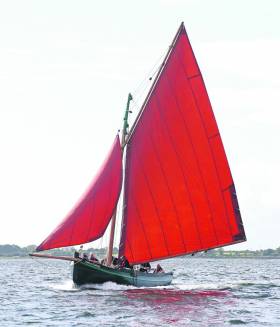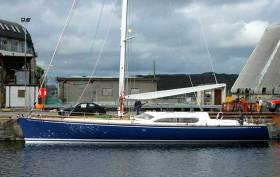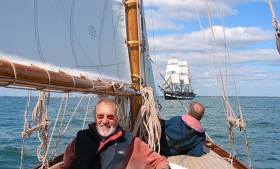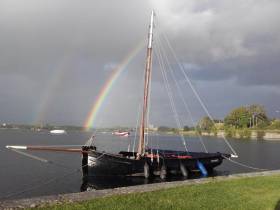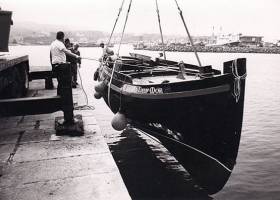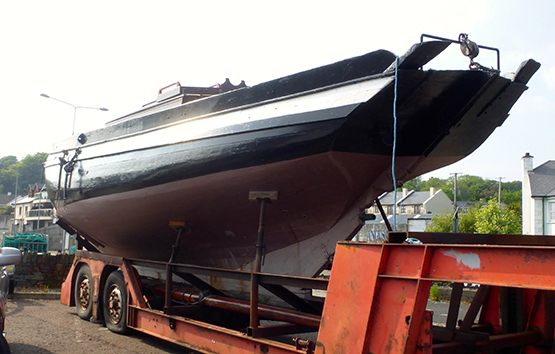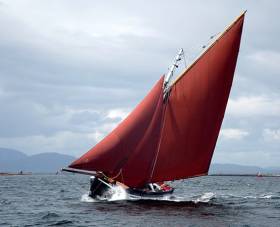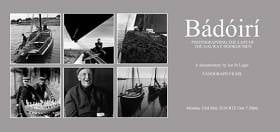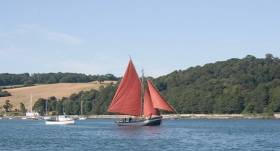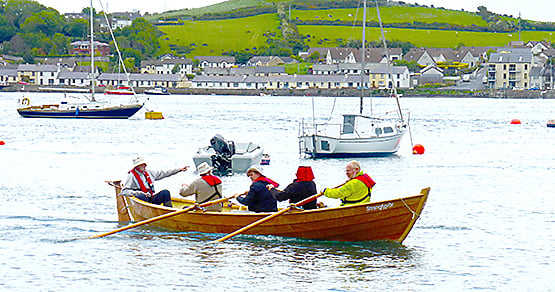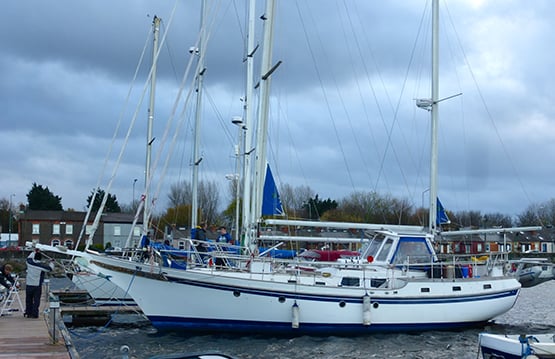Displaying items by tag: Galway Hooker
This weekend’s annual Cruinnui na mBad festival (the Gathering of the Boats) in Kinvara in the southeast corner of Galway Bay celebrates a tradition going back far into the mists of time writes W M Nixon. In the old days, it was a matter of necessity that the fleet of working Galway hookers in Connemara should sail up and across the bay, bringing the winter’s consignment of turf to a region where it’s a relatively scarce commodity.
The healthy mixture of commerce and effectively racing under sail, with festivities at the conclusion of a job well done, inevitably developed into a regatta atmosphere, West of Ireland style. So much so, in fact, that these days, the annual Cruinnui na mBad is a major event, which can attract a fleet of up to a hundred boats.
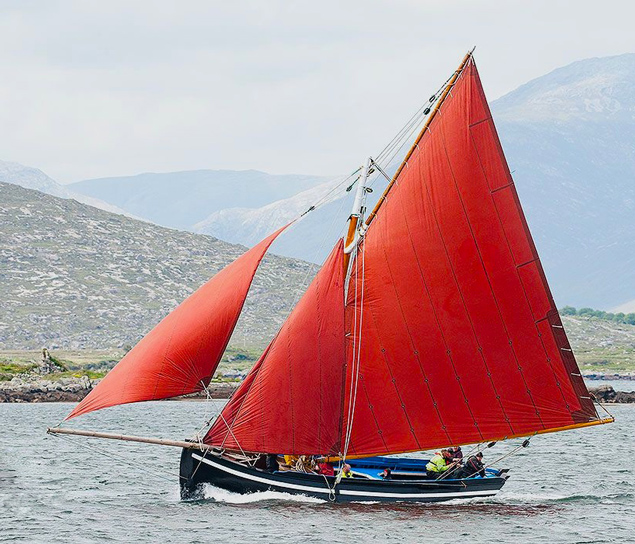 The spirit of Connemara. The Baily family’s classic An Capall making knots under a rugged western coastline
The spirit of Connemara. The Baily family’s classic An Capall making knots under a rugged western coastline
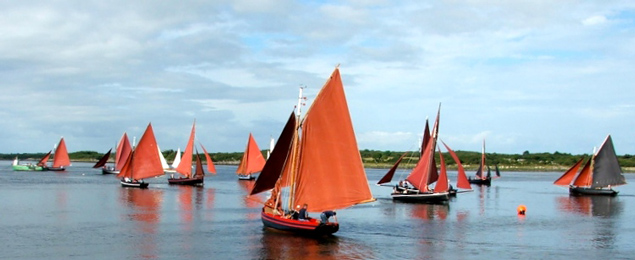 The Gathering of the Boats – some of the traditional fleet at Kinvara
The Gathering of the Boats – some of the traditional fleet at Kinvara
There’s now something extra to celebrate, as new boats to the traditional designs are being built at a steady rate by Colie Hernon and Peter Connolly and their team in Badoiri na Gaillimh in the Claddagh in Galway, and one of their creations is the central feature in the maritime display in the nearby City of Galway museum.
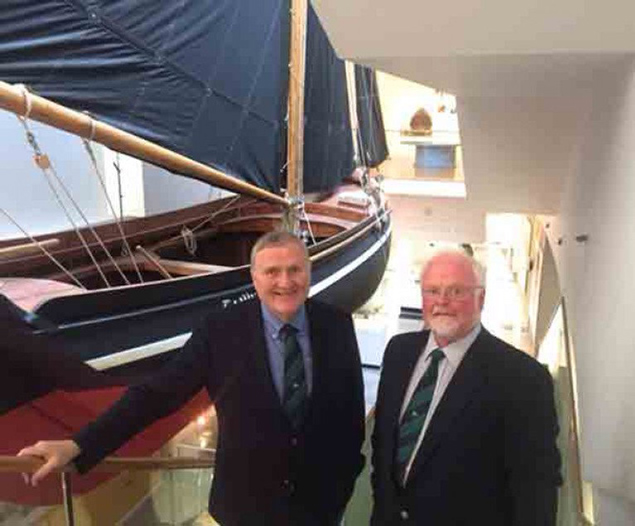 Jack Roy, President Irish Sailing (left) with Pierce Purcell of Galway and the traditional gleitog which is the centrepiece of the Maritime Section of Galway Museum.
Jack Roy, President Irish Sailing (left) with Pierce Purcell of Galway and the traditional gleitog which is the centrepiece of the Maritime Section of Galway Museum.
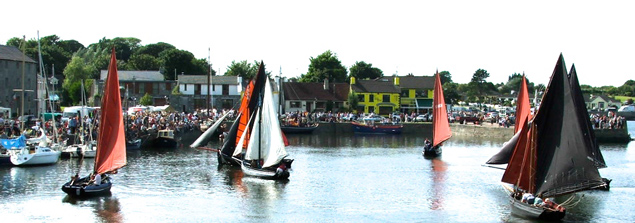 The fleet gathering at hospitable quayside in the heart of Kinvara
The fleet gathering at hospitable quayside in the heart of Kinvara
They are currently working on their seventh boat, a gleitog to be known as the Markeeen Joe. And a fine bit of work she is too, with completion anticipated for the Autumn. But they’ll be well represented by other craft they’ve built in Kinvara on Saturday and Sunday, when good weather is hoped to prevail until at least the middle of Sunday, and there’ll be no lack of proper sailing breezes.
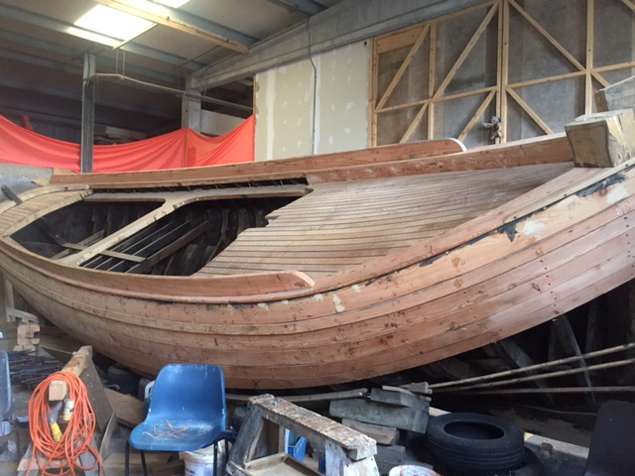 The new Markeen Joe under construction (above and below) in Galway city. Photo: Pierce Purcell
The new Markeen Joe under construction (above and below) in Galway city. Photo: Pierce Purcell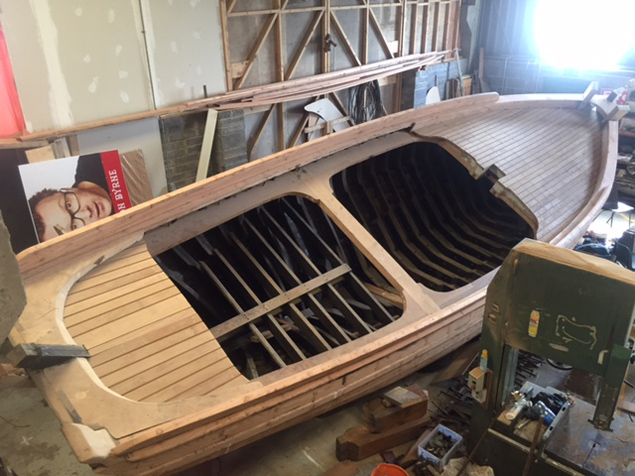
In Irish Sailing, The West's Awake
There is really no reasonable comparison between Ireland’s eastern and western seaboards writes W M Nixon. The east coast is quite densely populated, and while it has some areas of impressive scenery, in general it lacks the majestic inlets and islands which make sailing the Atlantic seaboard such a joy. That said, there’s no getting away from the fact that, taken overall, the east coast leads in economic activity, and at the very least there’s no doubting it has much less rain.
But when the rain in the west clears to reveal the coastline in all its glory, the extra precipitation seems a small price to pay for such visual natural abundance. And then too, while there are fewer people, they’re all so much larger than life, and bursting with innovative and entertaining ideas, that you’re inclined to think one western person is worth a dozen easterners.
However, those of us living and doing most of our sailing on the humdrum old east coast have one inescapable and total advantage over those in the west. When our east coast life gets too stressed and samey, we can escape for a while to the big country, fresh air and crazy attitudes of the west.
If you live in the west, you simply can’t genuinely experience this moment of release. But on the east coast, if life gets tedious, all that is necessary is head west for a day or two. The moment you cross the River Shannon, the spirits lift, and as you crest the watershed between the Shannon and Galway Bay, the big generous country of the west is rising on the horizon, and all is much better with the world.
In the west, too, they operate on a different time scale. And they do it in a different time zone. Until the railways of the 19th Century made some national co-ordination of time essential, local time meant that the recognised noon was later the further west you moved. As is only natural, Galway was twenty minutes later than Dublin. It was only with the exigencies of the Great War in 1916 that an Official Act was passed making uniform time-keeping a legal requirement. Oddly enough, no-one seems to have discussed what effect this draconian measure might have had in provoking the outbreak of the Easter Rising in 1916. Be that as it may, all we know for now is that in Galway, they still operate on a local time zone which is at least twenty minutes later than everyone else’s time, and is probably nearer half an hour.
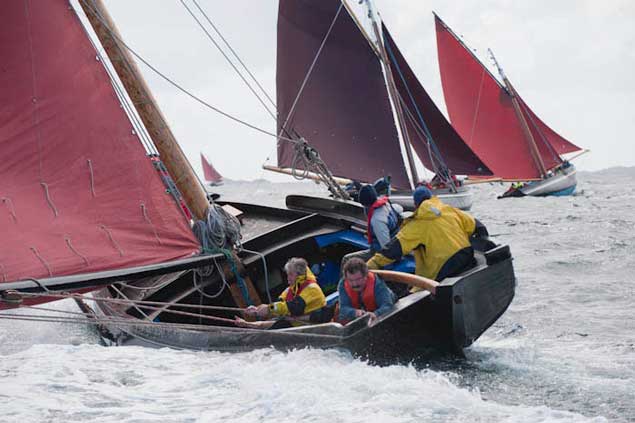 Galway hookers racing hard off the Connemara coast. This is the popular image of sailing in the west, but while vivid and true, the complete story of western sailing is much broader. Photo Paul Harris
Galway hookers racing hard off the Connemara coast. This is the popular image of sailing in the west, but while vivid and true, the complete story of western sailing is much broader. Photo Paul Harris
This became apparent last week when I wheeled into the car park at Galway Bay Sailing Club to give a performance of the current illustrated warblefest, which is about Ireland’s unique relationship with gaff rig and how it has emerged that Irish sailors led the switchover to Bermudan. The details of that will have to wait for another blog, but on this particular night, the immediate concern – with less than a quarter of an hour to go to the advertised start time – was that there just one other car in the car park, and that was Vice Commodore John Murphy, who was there a minute earlier to open the place up for the night.
“Oh Jaysus, Nixon” thought I, “you’ve bombed tonight, there’s not going to be a soul here.” But there wasn’t a moment to brood on the prospect of a showbiz flop, for I was with Pierce Purcell the mover and shaker of the west, and he wanted to show me the almost-finished refurb job they’ve been doing on the ground floor setup in the clubhouse, where they’ve managed to greatly enlarge the floor-space and rationalise its use for a state-of-the art changing room and multiple-use room and boat and equipment store setup.
You know the feeling you get when you’re looking at a job which is going very well indeed. It’s heartening. The re-furb in GBSC is precisely that. It’s being overseen by members Pat and Emer Irwin - he’s the Project Manager and she’s the Architect – and is being done with exemplary efficiency, on time and within a budget of only €160,000, which is the best value in building work I’ve ever seen anywhere.
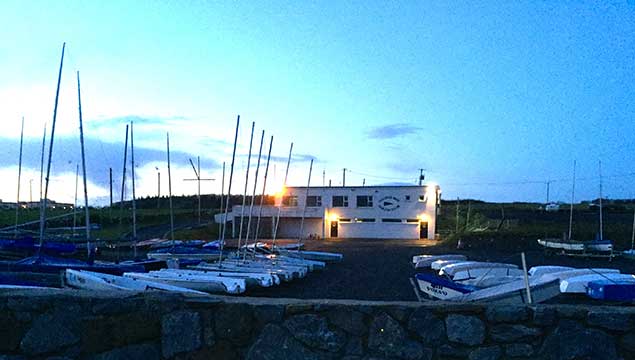 Galway Bay SC is nearing the completion of a clever refurbishment project which is within time, within budget, and excellent value. Photo Pierce Purcell
Galway Bay SC is nearing the completion of a clever refurbishment project which is within time, within budget, and excellent value. Photo Pierce Purcell
We emerged much encouraged from seeing all this to be further cheered by the fact the club was warming up with its famous big stove in the middle of the bar getting into its stride, and the place filling up with people from near and far. For of course I’d temporarily forgotten that Galway’s in a different time zone and it wouldn’t be until around 8.30pm that we’d have some idea of the real turnout, and how effective it might be for the yellow welly collection. This is an idea imported from Poolbeg Y & BC which provides the most painless way of raising funds for the lifeboats. You just provide one yellow RNLI seaboot and request the audience to see how many €5 notes they can get into it. Usually it concludes with some worthwhile figure inevitably ending in either zero or five, but Galway being Galway, the night concluded with the boot yielded up a sum ending with six euro and eight cents……
The show became something we all had to go through with, just in order to justify being there, so it went ahead and finally got to its meandering conclusion. Then the lights went up to reveal even more people had arrived. Pierce Purcell had certainly done his stuff in the phonecall chivvying department, for despite all your modern means of instant total-cover communication, the personal phone call seems to be more important than ever, and the photo below gives some indication of the coverage he achieved, while also hinting at the conviviality of an evening in which a shared love of boats and sailing and a good club atmosphere completely obliterated any feeling of it still being winter outside.
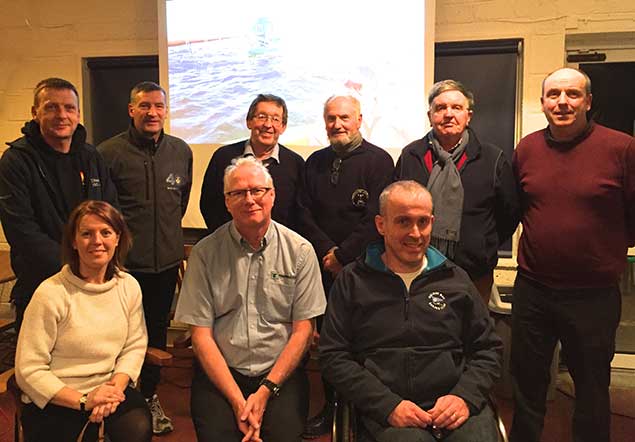 Western gathering. In Galway Bay SC are (back row, left to right) Simon McGibney (Commodore ICRA & ISA Board Member), John Leech (Commodore, Lough Derg YC), Afloat.ie’s W M Nixon, Adrian McConnell (Royal Western YC, Kilrush), Peter Fernie (Rear Commodore Irish Cruising Club) and Richard Glynn (Commodore, Royal Western of Ireland YC). Front row left to right Elaine O’Mahony, (outgoing Hon Sec Foynes YC, 2016 Volvo ISA Training Centre of the Year), Cormac McDonnacha (Chairman, WIORA Week), and Gary Allen, outgoing Commodore GBSC. Photo: Pierce Purcell
Western gathering. In Galway Bay SC are (back row, left to right) Simon McGibney (Commodore ICRA & ISA Board Member), John Leech (Commodore, Lough Derg YC), Afloat.ie’s W M Nixon, Adrian McConnell (Royal Western YC, Kilrush), Peter Fernie (Rear Commodore Irish Cruising Club) and Richard Glynn (Commodore, Royal Western of Ireland YC). Front row left to right Elaine O’Mahony, (outgoing Hon Sec Foynes YC, 2016 Volvo ISA Training Centre of the Year), Cormac McDonnacha (Chairman, WIORA Week), and Gary Allen, outgoing Commodore GBSC. Photo: Pierce Purcell
It was good to talk again with Barry Martin of Galway who made such an impact as bo’sun on the Asgard II many years ago that he found himself being recruited into the same role for both the much larger Britsh sail training schooners Winston Churchill and Malcolm Millar, a job in which he was so successful that he ended his sail training career as a senior officer on the Churchill.
There too were Jim Grealish and Barry Heskin, against whom we used to race inshore and offshore in the days when we each had boats around the 35ft size, boats of very different type yet rating notably similar, so if the Morrisssey-Grealish-Heskin squad appeared on the starting line with Joggernaut, aboard Witchcraft of Howth we knew we were into a boat-for-boat battle in which no quarter would be given, yet everyone would be the best of friends afterwards.
But if there was ample opportunity in GBSC for memories of good times past, equally there was plenty of discussion of the here and now, and it was fascinating to meet up with Dan Mill who runs the busy boatyard in the industrial estate beside Galway Docks. Dan’s story is such that we’ll be developing it into a complete blog in due course, sufficient to say at the moment that his links to Ireland are extraordinarily complex, for although he was born in England, at the age of three his parents together with another family set off to sail to New Zealand from Lymington in the then-bermudan-rigged 43ft Tyrrell ketch Maybird, and Maybird of course is now back in Ireland fully restored as a gaff ketch, and well-known in the ownership of Darryl Hughes.
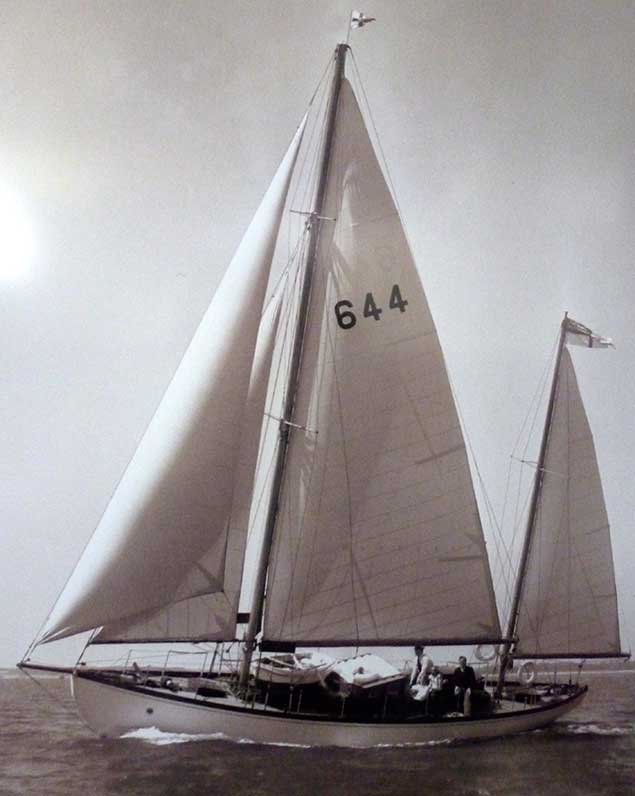 Maybird as a Bermudan ketch. It was under this rig that Dan Mill sailed on her from England to New Zealand while still a child
Maybird as a Bermudan ketch. It was under this rig that Dan Mill sailed on her from England to New Zealand while still a child
As for young Dan, growing up in New Zealand he naturally moved into boat-building in what is probably the best boat-building school in the world, the New Zealand marine industry. But then Mna na hEireann took a hand in his life-path.
It would be difficult to overestimate the influence that the charms of the Women of Ireland have had on the development of a small yet top-level boat-building industry in this country. But there’s something about marine craftsmen and Irish women which gets them together and entices the craftsmen to settle in Ireland despite the fact that, let’s face it, anyone trying to produce such top quality work here is ploughing a lonely furrow a long way from the great centres of the specialist industry, such as the Solent district, parts of the Baltic, certain places in Brittany, and particularly New Zealand.
Yet the women get them, and they get them home to Ireland, and they keep them. Thus we have the likes of Dan Mill in Galway, Steve Morris in Kilrush, and Bill Trafford in the hidden depths of the country near Mitchellstown, all three of them trying to ensure work of the highest quality in a country where “Ah sure, ’twill do” is sometimes the defining motto in woodwork.
Having arrived in Galway, Dan Mill found himself within the orbit of the formidable John Killeen, with whom all ideas are possible, and somehow they found themselves setting out to build a cruising version of an Open 60.
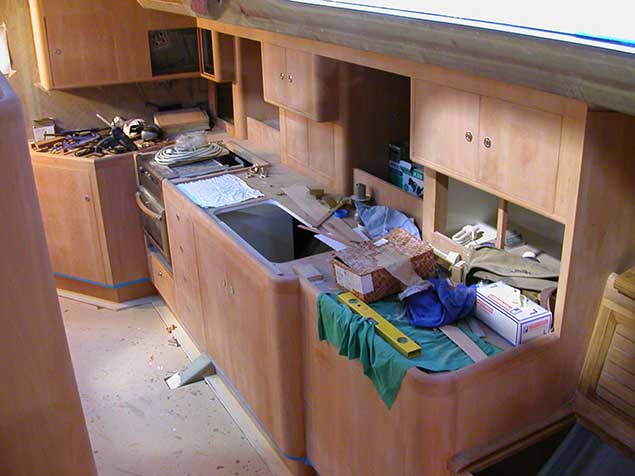 The galley area in Nimmo under construction
The galley area in Nimmo under construction
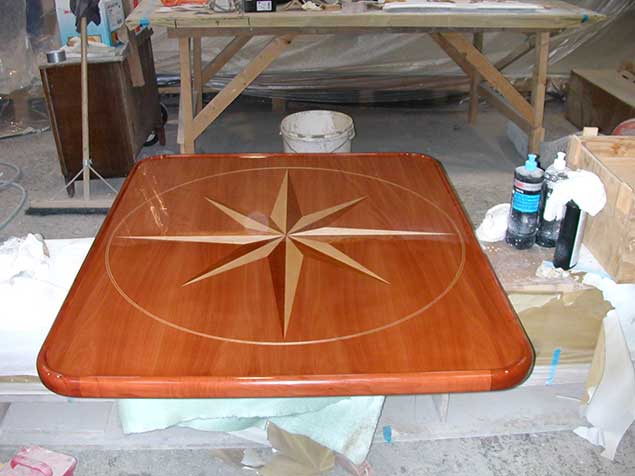 Beauty in detail – Dan Mill’s craftsmanship in evidence on a table for Nimmo.
Beauty in detail – Dan Mill’s craftsmanship in evidence on a table for Nimmo.
In the end she became a very one-off 68-footer named Nimmo in honour of the great Scottish harbour engineer Alexander Nimmo, who is one of John’s heroes. When she was eventually finished after four years with Dan being responsible for virtually every bit of skilled work in her complex construction and superb finish, he was exhausted, but his reputation in Galway was well established at a very high level, and he’s now the man to go to with boat maintenance needs and problems. He’s not above undertaking a mid-level job such as putting a new deck and coachroof on an older fibreglass hull, but as for launching another project on the Nimmo scale, that would require some thinking about.
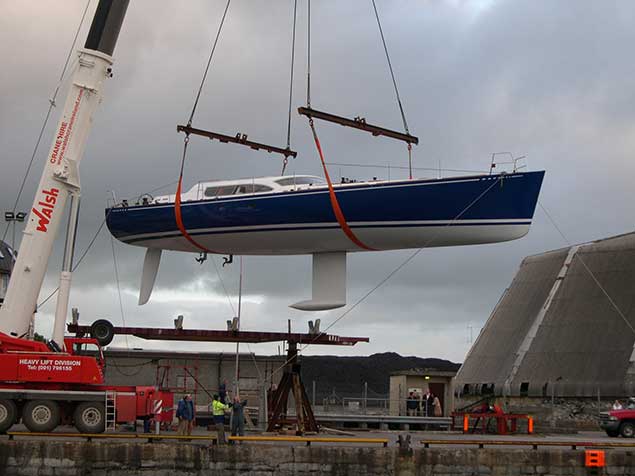 Launching day for Nimmo, built in a very basic shed in Galway
Launching day for Nimmo, built in a very basic shed in Galway Dan Mill this week in the boat yard in Galway
Dan Mill this week in the boat yard in Galway
Nevertheless, talking with the man who built Nimmo was an eloquent reminder that there’s a lot more to sailing in the West than Galway Hookers and other traditional craft. But equally it was a reminder that the traditional skills are still being maintained and indeed nourished out beyond the Pale. So after a leisurely breakfast next morning with Pierce and Susan Purcell in their dream house in Clarinbridge, with a busy red squirrel feasting on the bird table close outside the generous window, there was time to inspect Pierce’s boatshed out the back, one of those green steel sheds which sit so well in the Irish countryside, particularly when – like Pierce – you have your 26-footer comfortably winterised in it, and a fine well-equipped workbench right to hand.
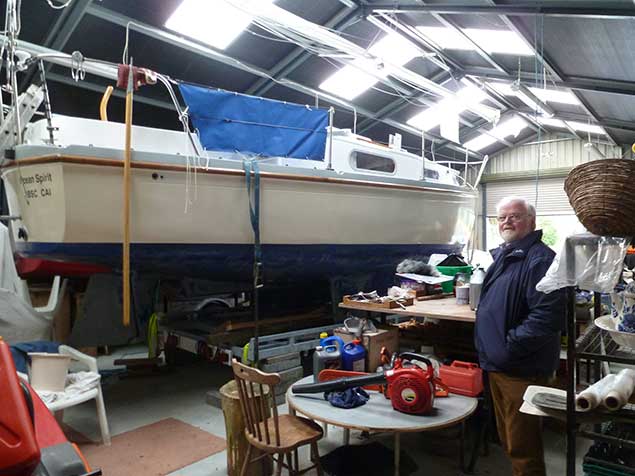 What price a facility like this at your house on the East Coast? Pierce Purcell in “the little shed out the back” at Clarenbridge Photo W M Nixon
What price a facility like this at your house on the East Coast? Pierce Purcell in “the little shed out the back” at Clarenbridge Photo W M Nixon
It’s the sort of ideal setup very few can manage on the over-crowded East Coast, and I headed south musing on the east-west imbalance, and readying the thinking for something entirely different - the Ilen Boat-Building School in Limerick. This started as the backup service for the restoration of the Conor O’Brien 57ft ketch Ilen by Liam Hegarty at Oldcourt near Baltimore, and recently in the Ilen School they’ve produced deckhouses for Ilen to the highest standard, and are currently finishing the last of the new spars.
But under the inspiration of Gary MacMahon (who personally was responsible for bring Ilen home from the Falklands) and others such as Brother Anthony Keane of Glenstal Abbey, the Ilen School has become a remarkable educational and training resource undertaking a wide variety of projects such as creating replicas of the traditional Shannon Estuary gandelows, and building a class of the very handy CityOne sailing dinghies to a design by the late Theo Rye, a successful project which further revealed the multiple talents of that much-mourned expert in every aspect of naval architecture.
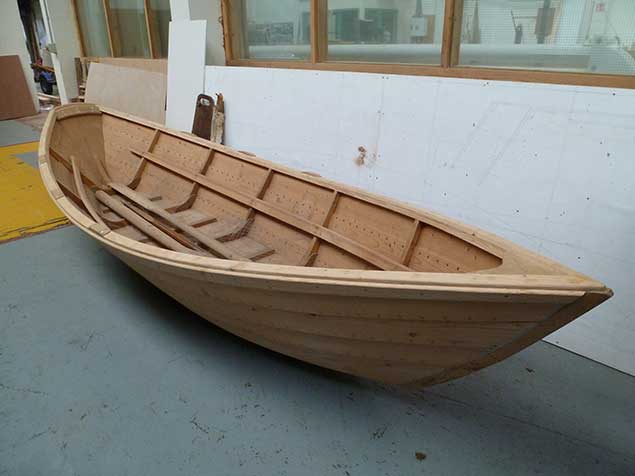 Courses constructing traditional Grand Banks Dories provide popular night classes at the Ilen Boatbuilding School in Limerick. Photo W M Nixon
Courses constructing traditional Grand Banks Dories provide popular night classes at the Ilen Boatbuilding School in Limerick. Photo W M Nixon
Another handy course which the Ilen School offers is through building traditional Grand Banks dories, simple yet effective boats which must have seemed very small indeed as you were left behind in the Grand Banks fog by the Bluenose fishing schooners to get on with the day’s business of ling-lining for cod. By the time the schooner found you again towards evening, your little dory would be dangerously laden with a great catch of wet and scaly silvery wealth.
In fact, the Ilen School is a whole host of experiences, for there in the main work-space were the mighty new spars for Ilen together with the distinctly aged original gaff which goes all the way back to Tom Moynihan and his shipwrights in Baltimore 91 years ago. And in another workspace, the Ilen team are building two very able little dinghies to the Valentine type from dimensions supplied by Hal Sisk, and they will in time be Ilen’s boats. But before you get to these sensibly–shaped little dinghies, you’ve to take on board the Hildasay, the Ilen school’s latest acquisition.
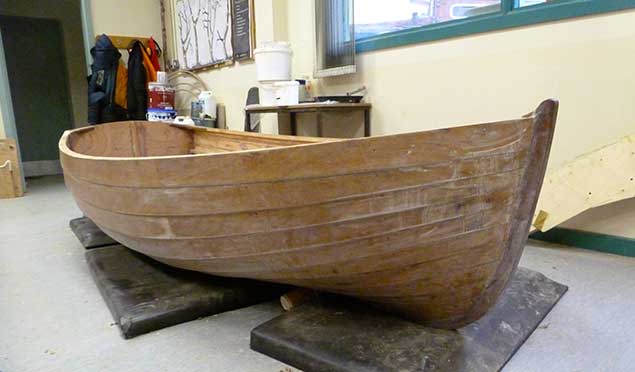 The Valentine dinghy, from plans provided by Hal Sisk, has been built at the school to be a ship’s boat for Ilen. Photo W M Nixon
The Valentine dinghy, from plans provided by Hal Sisk, has been built at the school to be a ship’s boat for Ilen. Photo W M Nixon
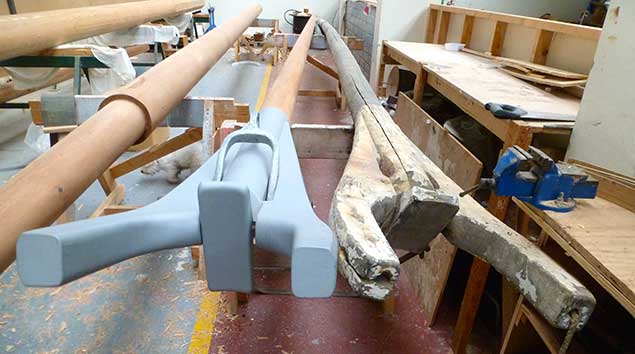 Ilen’s new main gaff boom (left) and the original (right), which was shaped in Baltimore in 1926. Photo W M Nixon
Ilen’s new main gaff boom (left) and the original (right), which was shaped in Baltimore in 1926. Photo W M Nixon
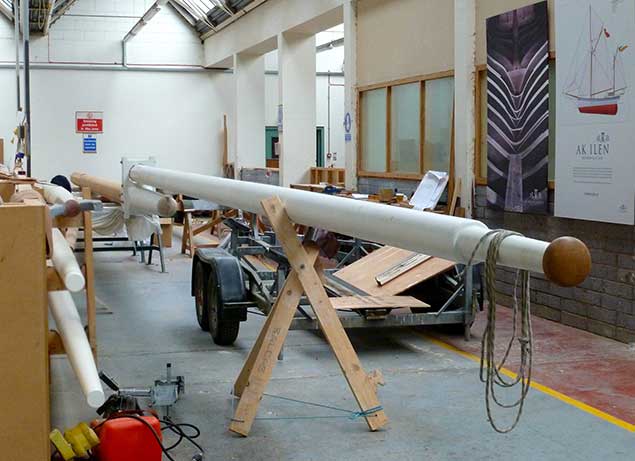 The mighty mainmast for Ilen, with topmast temporarily in place in Limerick, is ready for dismantling and transport to Baltimore. Photo W M Nixon
The mighty mainmast for Ilen, with topmast temporarily in place in Limerick, is ready for dismantling and transport to Baltimore. Photo W M Nixon
We all know that Limerick is a Viking city, in fact there are those who would argue that it still is, and in its rawest state too. But nevertheless it takes a while to get your head round how a boat like Hildasay, of the very purest Viking descent, should have ended up in a big shed in a trading estate in Limerick.
Hildasay was built in Shetland as a sailing development of the traditional clinker-built sixareen (six oars) in 1951, and is such a sweet little 26-footer that your heart falls for her, even if your head tells you that the slim Viking stern mean there’s very little space just where you most need it most, while the classic clinker construction poses its own special maintenance problems in a vessel which is a semi-keelboat.
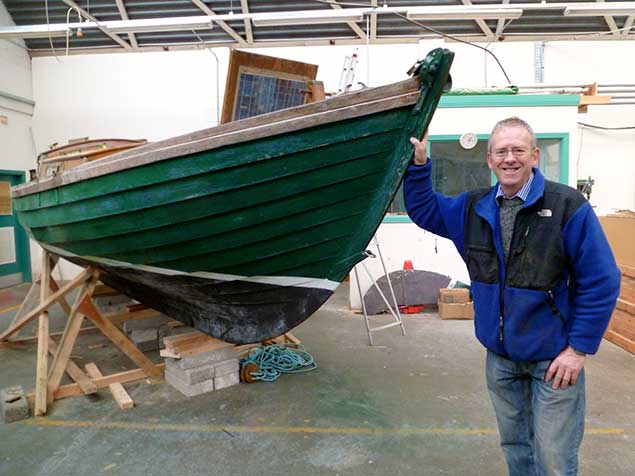 Jack Hawks with the Shetland sailing sixareen Hildasay, whuch he has donated to the Ilen Boatbuilding School. Photo: W M Nixon
Jack Hawks with the Shetland sailing sixareen Hildasay, whuch he has donated to the Ilen Boatbuilding School. Photo: W M Nixon
She has been in and around the Shannon Estuary for abut 15 years, but owner Jack Hawks was recently seriously ill, and though he has fully recovered he felt the demands of Hildasay were getting a little too much for him, and wondered if the Ilen Boat Building School would be interested in her as a gift.
She’s an ideal gift, as she’s of a size to be very manageable, she provides special maintenance problems which, while not enormous, are very educational as part of the school’s courses, and each summer when she’s in commission she could be based either on Lough Derg, or somewhere down the Estuary.
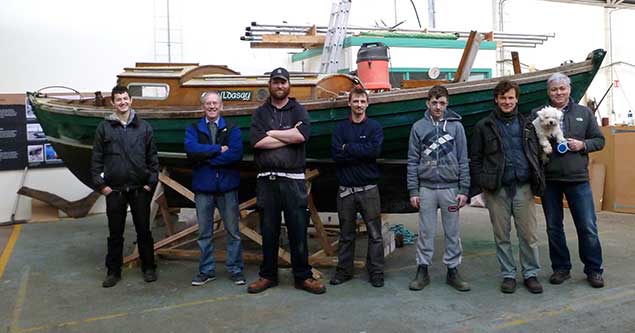 The “day team” at the Ilen School with their new acquisition Hildasay include Luki O’Brien, Jack Hawks, Elan Bromley, Owen Lacey, Sid Dorchenas, Matt Diss, Gary MacMahon and Luna MacMahon. Photo W M Nixon
The “day team” at the Ilen School with their new acquisition Hildasay include Luki O’Brien, Jack Hawks, Elan Bromley, Owen Lacey, Sid Dorchenas, Matt Diss, Gary MacMahon and Luna MacMahon. Photo W M Nixon
The problem in Limerick is that though the Shannon is very much in the midst of it, access to it in the heart of town is limited, and in any case below the weir the big tides are a problem. But up on Lough Derg or further down the Estuary, there are all sorts of opportunities to get conveniently afloat, and having the use of an interesting sailing boat which is bigger than a CityOne or a gandelow is a natural add-on to the Ilen School’s activities, providing a broadening of the mind for some young would-be boatbuilders who may have spent too much time solely at the workbench without seeing what the resulting use of the end product is all about. And who knows, but they might even manage a race with the lovely gaff cutter Sally O’Keeffe built by Steve Morris of Kilrush with the community team from nearby Querrin as a replica of the traditional Shannon Estuary trading hooker.
Having seen the possibilities of mind-broadening in Limerick, the final part of this western tour took in a project which is mind-blowing. Admittedly the good people of the townland of Skenakilla would never for a minute think of themselves as being in the west, but for the rest of us this hidden spot beyond Mitchellstown in North Cork seems to be in the middle of nowhere. But then when you’ve found it, and spent a bit of time with the ebullient Bill Trafford in his remarkable Alchemy Marine boat workshop in Skenakilla, you feel you’re at the hub of the universe.
Bill is another case of Mna na hEireann reeling them in – a classic yachtbuilder and particularly an enthusiast for the International 6 Metre Class, he met an Irish girl and that was that. He made a living plying his highly specialized trade the length and breadth of our island working from a van, and then discovered his own niche in doing interesting, indeed extraordinary things, with old fibreglass boats.
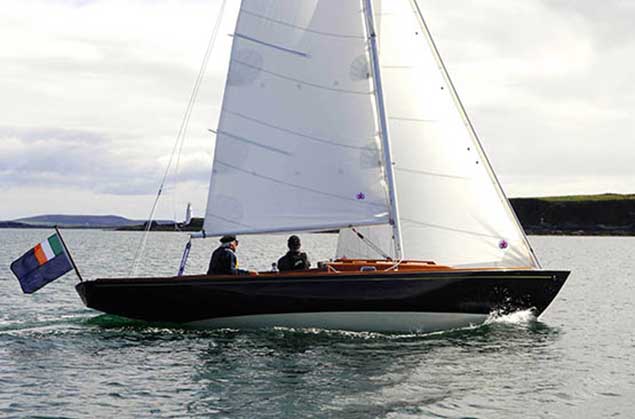 Bill Trafford’s transformation of an Elizabethan 23 won international awards last year.
Bill Trafford’s transformation of an Elizabethan 23 won international awards last year.
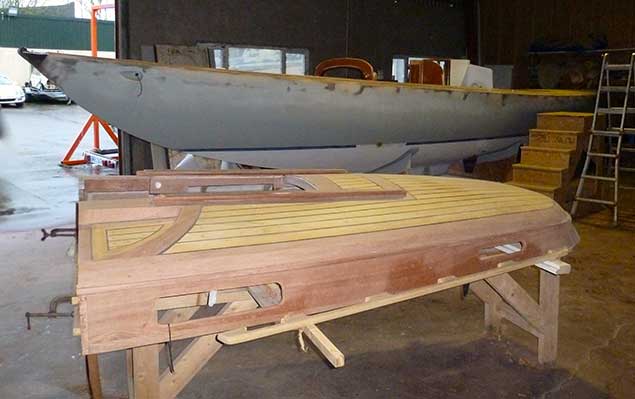 Bill Trafford’s current project at Alchemy Marine is the transformation of an Etchells 22 into a weekend cruiser by raising the freeboard, and providing a beautifully-made coachroof (foreground) Photo: W M Nixon
Bill Trafford’s current project at Alchemy Marine is the transformation of an Etchells 22 into a weekend cruiser by raising the freeboard, and providing a beautifully-made coachroof (foreground) Photo: W M Nixon
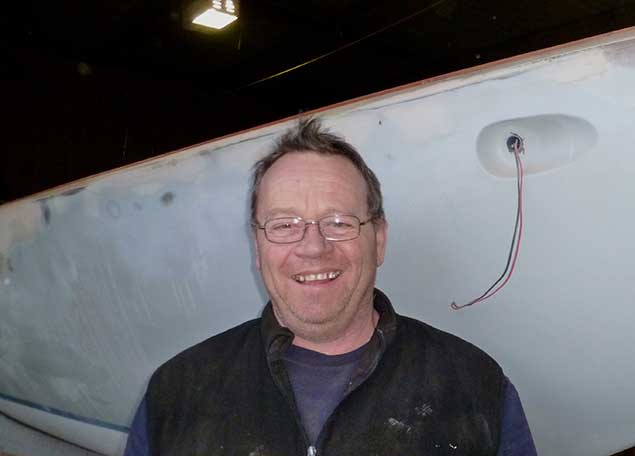 Bill Trafford – he is as enthusiastic about the full potential of glassfibre construction as he is about using classic yacht joinery work. Photo W M Nixon
Bill Trafford – he is as enthusiastic about the full potential of glassfibre construction as he is about using classic yacht joinery work. Photo W M Nixon
He’s unusual in that he’s as enthusiastic about the wide potential of glassfibre construction as he is profoundly satisfied by working in wood to the highest classic yacht standards. While his special abilities were well known to a select few, he came to international notice last year when one of his masterpieces, the complete re-working of a seemingly tired little Elizabthan 23 into an elegant 26ft sloop with a classic New England style, was awarded a top prize in the Classic Boat annual competition.
His current project for a Cork owner is even more intriguing, the transformation of an ordinary and no longer young Etchells 22 into a 34ft LOA day cruiser of unique appearance. He has raised the topsides using glassfibre moulding to give her a completely fresh sheerline, he has transformed the stern by giving it a new-look counter with a curving transom which gives more than a nod in the direction of the unique sterns of the Friendship sloops of Maine, and he has built the most beautiful coachroof in the best Knud Reimers style to provide a boat which comes with a heady combination of Down East and Scandinavia to her.
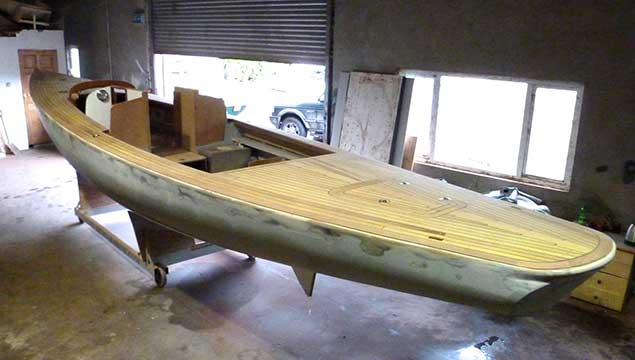 The lengthened stern has seen the rudder being moved aft by half a metre to provide a much roomier cockpit. Photo: W M Nixon
The lengthened stern has seen the rudder being moved aft by half a metre to provide a much roomier cockpit. Photo: W M Nixon
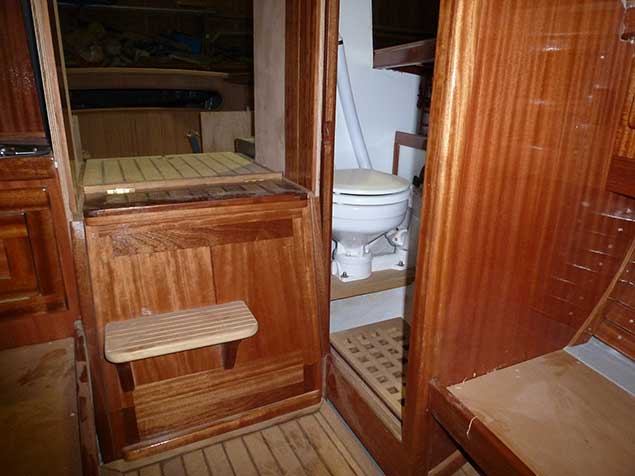 While compact, the accommodation provides for weekend cruising, but it’s expected to be comfortable day sailing which will be the best use of the “new” boat. Photo: W M Nixon
While compact, the accommodation provides for weekend cruising, but it’s expected to be comfortable day sailing which will be the best use of the “new” boat. Photo: W M Nixon
The stern is lengthened such that the LOA is now 34ft instead of the original 30.5ft, and the possibilities this has provided for a large cockpit to match the very pleasant accommodation (including a proper toilet compartment and a Beta diesel auxiliary) have been met by moving the entire rudder half a metre aft.
With his experience of tweaking boats this way and that, Bill reckons the sailing balance will if anything be improved by this re-location of the rudder. Personally, in the standard Etchells I’d always thought it too far forward anyway, so I could live with this change, yet found it entertaining to note that while he talked of moving the rudder aft by half a metre, when I asked him how he calculated the perfect-looking camber in the new deck, he said his rule of thumb is one inch for every four feet of beam. This is as near as dammit one in fifty, but his mixture of measurement systems makes him just like the rest of us who are mere bodgers, for when we’re measuring something we just use the side of the steel rule which comes up first, be it metric or imperial…….
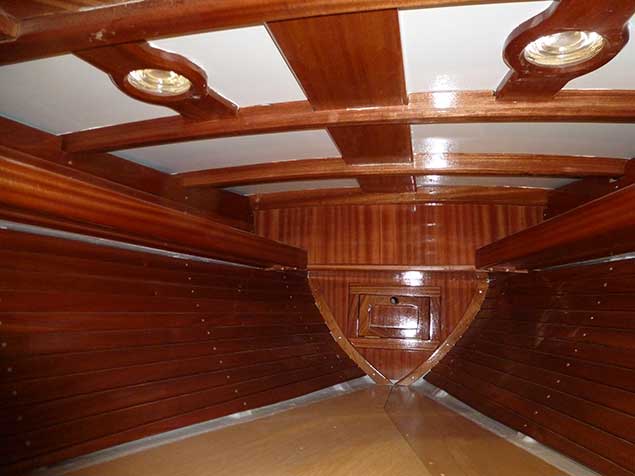 Under the new foredeck – Bill’s rule of thumb is a deck camber of one in 48. Photo: W M Nixon
Under the new foredeck – Bill’s rule of thumb is a deck camber of one in 48. Photo: W M Nixon
This is very much a bespoke project, so Bill has been able to introduce all sorts of quirky little features, a very attractive one being the ports for the navigation lights, which are set well into the hull either side of the stemhead, and look for all the world like the eyes put in Mediterranean boats to ward off evil spirits. In fact, they give such an appearance of good cheer to this new-old boat that when you see her from ahead, she looks for all the world as though she is smiling so much that she’s about to burst out laughing.
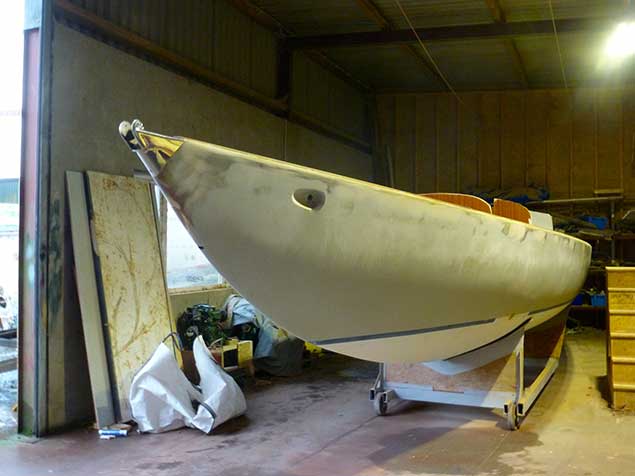 The Watchful One…….it was a Bill Trafford’s idea to build special ports for the navigation lights. Photo W M Nixon
The Watchful One…….it was a Bill Trafford’s idea to build special ports for the navigation lights. Photo W M Nixon
There’s still quite a bit to do before she’s ready for the water, but Bill is now in such a rhythm of working on his own that he can put in long productive hours without really noticing it, so we hope to get back to Skenakilla sooner rather than later. As for those around him, one unexpected advantage of being near Mitchellstown is you’re right in the heart of the dairy engineering industry, where the use and working of stainless steel is second nature. In fact, down there they sometimes use stainless steel which is of a superior grade to the 316 which is usually good enough for the rest of us.
Truth to tell, I didn’t know there were types of stainless steel superior to 316, but you learn many things down in Skenakilla, and it was encouraging to hear that the best workers in the stainless steel fabricating shops are happy to lend their skills in their spare time to bring Bill’s self-made stainless steel fittings up to professional standards of finish.
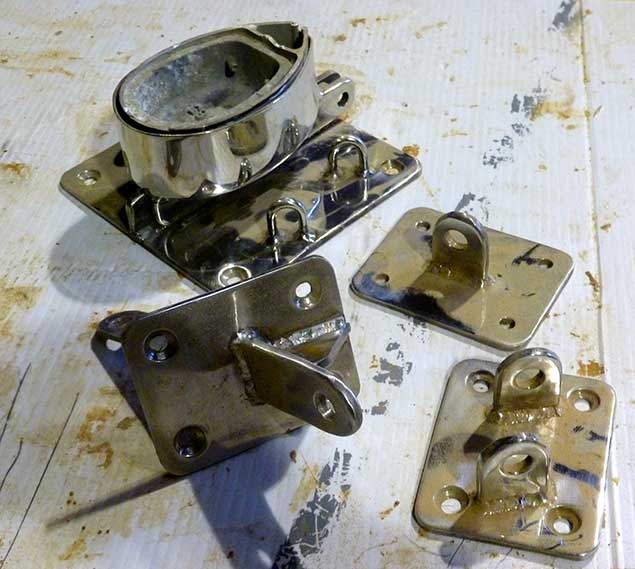 Thanks to the local presence of high-grade stainless steel engineering for the dairy industry, it has been possible to make these fittings in Skenakilla. Photo: W M Nixon
Thanks to the local presence of high-grade stainless steel engineering for the dairy industry, it has been possible to make these fittings in Skenakilla. Photo: W M Nixon
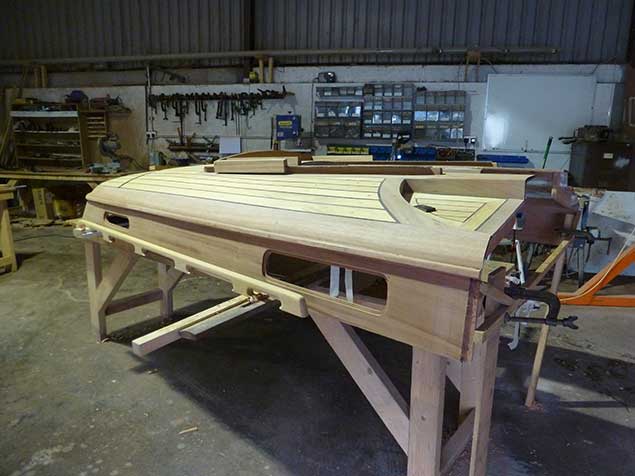 A work of art in its own right, the new coachroof will be fitted any day now. Photo: W M Nixon
A work of art in its own right, the new coachroof will be fitted any day now. Photo: W M Nixon
All being well, the new boat will be a star at the 25th Anniversary Glandore Classics Regatta from July 23rd to 29th, in fact Bill rather hopes the owner might consider taking her to the Classics Regatta celebrating the Bicentenary of Dun Laoghaire Harbour from July 6th to 9th as part of Volvo Dun Laoghaire Regatta.
The good news here is that Cathy MacAleavey, chair of the Dun Laoghaire Classics organising committee, and Sally Wyles, who heads up the Glandore organisation, got together last weekend to see about selling their two events as a sort of package, as the clear fortnight between them makes participation in both a very realistic proposition.
Certainly the Dun Laoghaire Classics is beginning to look impressive, particularly if you go by the measuring method of counting the number of famous designers involved. The recent interest shown by Rob Mason of Milford Haven to come over with his newly-restored 36ft Alexander Richardson-designed 36ft Myfanwy brings a once-famous Liverpool designer back into the limelight. It’s where he deserves to be, for Richardson designed John Jameson’s all-conquering Irex in 1884.
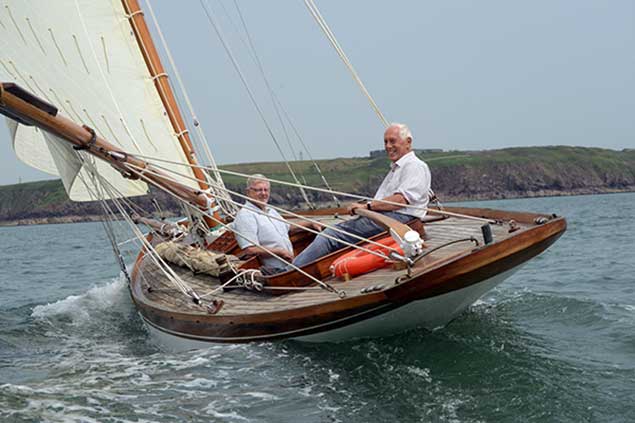 Rob Mason with his restored 1897 Alexander Richardson 36-footer Myfanwy off Milford Haven. He has indicated interest in participation in the Bicentenary Regatta in Dun Laoghaire in July
Rob Mason with his restored 1897 Alexander Richardson 36-footer Myfanwy off Milford Haven. He has indicated interest in participation in the Bicentenary Regatta in Dun Laoghaire in July
In Dublin Bay, Myfanwy would see this Richardson creation shaping up to designs by G L Watson, Alfred Mylne, William Fife, John Kearney, O’Brien Kennedy, Arthur Robb and others, and that’s the list already with the net only newly cast.
As for what Glandore can offer, there’s at least one unique proposition. A special race will be sailed to honour the memory of Theo Rye, the fleet including the CityOnes from Limerick and a host of other boats, new and old. On each and every one of them, Theo would have had something new and of real interest to say, for that’s the kind of devoted student of naval architecture he was throughout his far-too-short life. He is much missed.
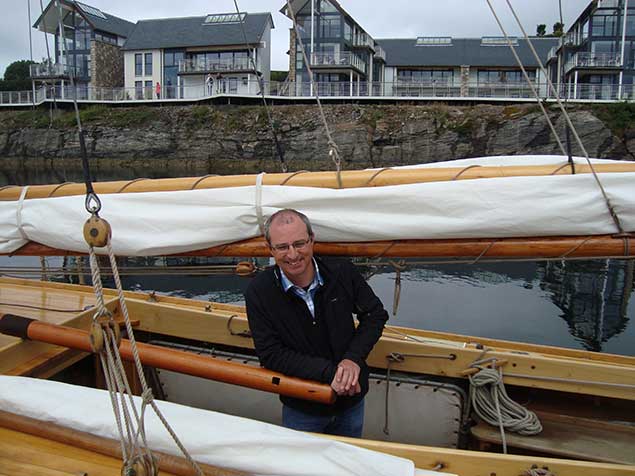 Much missed. The late Theo Rye aboard the 1887 Fife cutter Ayrshire Lass, which was restored by Michael Kennedy at Dunmore East. Theo Rye will be commemorated in a special event at the 25th Anniversary Glandore Classics Regatta from July 23rd to 29th. Photo: Darryl Hughes
Much missed. The late Theo Rye aboard the 1887 Fife cutter Ayrshire Lass, which was restored by Michael Kennedy at Dunmore East. Theo Rye will be commemorated in a special event at the 25th Anniversary Glandore Classics Regatta from July 23rd to 29th. Photo: Darryl Hughes
Dun Laoghaire Regatta Casts Net To Celebrate Kingstown Bicentenary
There could well be as many opinions as to what constitutes a true classic or traditional boat as there are owners of these often highly individual craft. As part of the celebration of the Bicentenary of Dun Laoghaire Harbour – where the first stone was officially laid by the Viceroy on 31st May 1817 - the organisers of the Volvo Dun Laoghaire Regatta 2017 (it’s from July 6th to 9th) will be including a Classics, Traditional and Old Gaffer section. This will, in addition to putting extra emphasis on older classes already regularly involved such as the Glens, the Mermaids, the Howth 17s, the IDRA 14s and the Water Wags, be extending a welcome to older boats of other types, and to classic classes from Ireland and around the Irish Sea. W M Nixon reports on progress in this special feature of a very attractive new dimension to Ireland’s biggest sailing event.
If you want anything done in introducing a new twist to sailing, make Cathy MacAleavey the organiser of the special sub-committee in charge of moving things along. And if you want to be sure things are going in the right direction as regards classics and traditional craft, make sure that that Hal Sisk is being consulted and will be personally involved in one or maybe all of his classic craft, for the contribution he has made to the appreciation of our boat heritage in Ireland is unmatched.
Former Olympic sailor and round Ireland record holder Cathy is now herself very much a mover and shaker in the classics, as she has built a Water Wag and a Shannon One Design working alongside the great Jimmy Furey of Leecarrow in Roscommon, and races regularly in both classes.
On being appointed to this completely new post last Autumn by top honcho Tim Goodbody, Chair of the overall Organising Committee, one of the first things she remembered was that while taking part in the Glandore Classics some years ago, she’d been much taken with the Fife One Designs from the Menai Straits, little gems some 24ft 6ins LOA whose design origins go back to 1926, and have been thriving as a class since the 1930s.
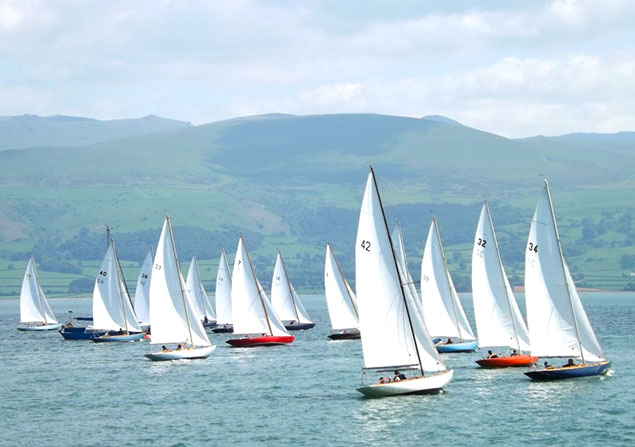 The Royal Anglesey Fifes racing in the Menai Straits. Although the class was first designed in 1926, and gained full strength early in the 1930s, this will be their first visit to Dun Laoghaire. Photo: Ian bradley
The Royal Anglesey Fifes racing in the Menai Straits. Although the class was first designed in 1926, and gained full strength early in the 1930s, this will be their first visit to Dun Laoghaire. Photo: Ian bradley
These days they hunt as a pack and many of them are well organised for road trailing, so on the assumption that they would be heading to the Glandore Classics 2017 on July 23rd, she sent an email to class chairman Richard Tudor suggesting that they might like to take in Dun Laoghaire on the way. It turns out that they won’t be at Glandore in late July as they’re expected to take part in the four yearly Celtic Festival in the Menai Straits at much the same time. But their diary was reasonably clear for the 6th to 9th of July and the Dun Laoghaire festivities, and they’re coming to race for the new Kingstown Cup big time.
This is doubly interesting, for they’re very much a William Fife design and only six inches shorter than the Alfred Mylne-designed Glens, yet the two comparable classes have never raced in the same event. Needless to say the chances of an inter-fleet race in Dun Laoghaire is now high on the agenda.
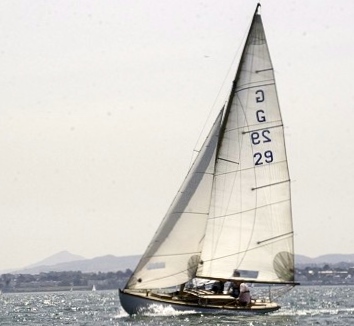 An Alfred Mylne-designed Glen Class OD on her home waters of Dublin Bay in the kind of conditions everyone hopes for in July 2017.
An Alfred Mylne-designed Glen Class OD on her home waters of Dublin Bay in the kind of conditions everyone hopes for in July 2017.
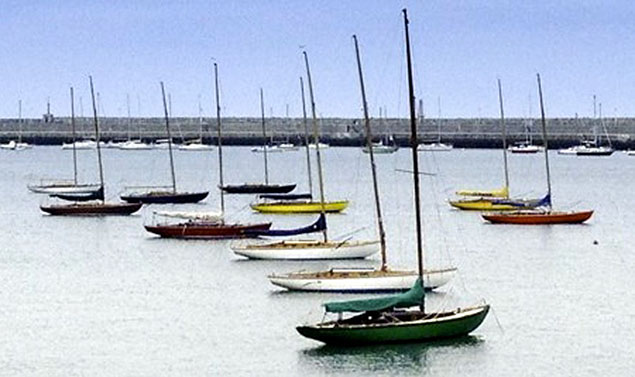 The Glen class neatly demonstrate their need for traditional moorings in their allocated area off the Royal St George YC
The Glen class neatly demonstrate their need for traditional moorings in their allocated area off the Royal St George YC
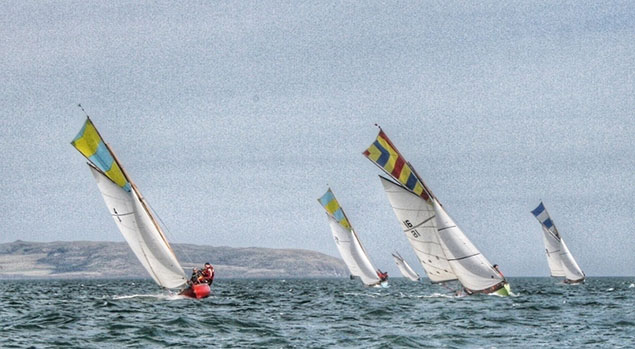 The 1898 Howth 17s will be coming in force from Howth, but they’ve adapted the programme to suit their needs, with a race from Howth to Dun Laoghaire on the Friday, a full day’s racing on the Saturday, a morning race on the Sunday, and then a race home after the prize-giving ceremony.
The 1898 Howth 17s will be coming in force from Howth, but they’ve adapted the programme to suit their needs, with a race from Howth to Dun Laoghaire on the Friday, a full day’s racing on the Saturday, a morning race on the Sunday, and then a race home after the prize-giving ceremony.
So at a stroke, Cathy had given wings to the new event. But at the same time she was casting a fly over Hal Sisk, against whom she regularly races in the Water Wags, but who had his 1894 Watson-designed, Hilditch-built 36ft classic gaff cutter Peggy Bawn on the market, as more than ten years have elapsed since his team completed the wellnigh perfect restoration of this boat in 2005.
Peggy Bawn had been based in Dun Laoghaire Harbour continuously since 1919, and then after her restoration, she became a much-admired feature in classic regattas on both sides of the Atlantic. To say that Hal Sisk has done his duty by her is under-stating the case, yet when Cathy approached him about making Peggy Bawn the centrepiece of the VDLR Classics Regatta, he said he’d already decided to do so, and was looking forward to it very much.
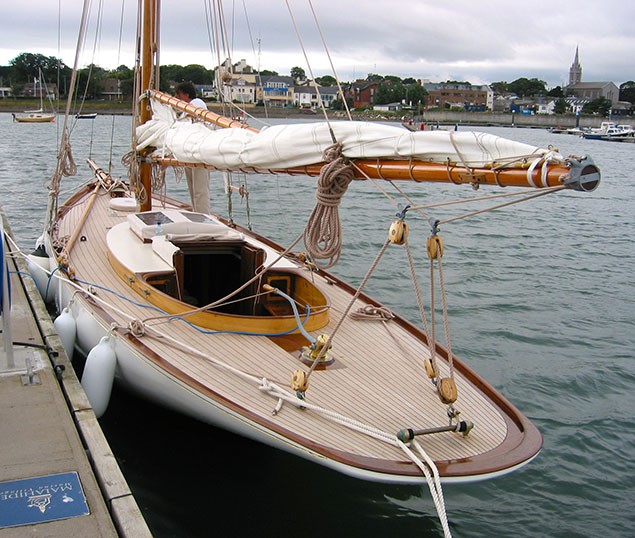 Peggy Bawn in her newly-restored form in 2005. Anyone contemplating a similar project should spend hours studying this image……Photo W M Nixon
Peggy Bawn in her newly-restored form in 2005. Anyone contemplating a similar project should spend hours studying this image……Photo W M Nixon
While all this was going on in the background, one of the members of Cathy’s sub-committee, Guy Kilroy, was constructing a database of all the classic and traditional classes within Ireland or within reasonable reach. Although most of them are very location-specific and few have the trailers for a long road journey, you just never know who might be swept up in the general enthusiasm for an event which is really beginning to buzz, and certainly the exotic Shannon One Designs will be turning up in strength.
Meanwhile, there’s the mysterious territory which is the Old Gaffer’s Association, which came into being in 1963 when people realised there wasn’t any organisation looking after the needs of boats which weren’t really classics in the strictest sense, yet fitted into so many other categories that they almost defied definition.
Ironically, the OGA was founded in the very year that Dublin Bay’s perfect exemplars of the gaff-rigged racing cutter, the Dublin Bay 21s, changed over to Bermudan rig. Yet as the 2013 Golden Jubilee Round Britain and Ireland cruise of the OGA showed, the Old Gaffers thrive as never before. And as it happened, in 2015 and 2016 the President of the overall Old Gaffers Association was Dun Laoghaire’s own Sean Walsh, owner-skipper of the very gaff-rigged Heard 28 Tir na nOg.
But Sean was due to stand down as President in London in January 14th 2017 – last weekend, in other words. Fortunately, there was just time to convene a meeting of key people before that happened, and a gathering in the NYC of Sean Walsh, Dublin Bay OGA President Denis Aylmer, Ian Malcolm of the Howth Seventeen and Water Wag classes, and Cathy MacAleavey and her husband Con Murphy, did a lot to improve mutual understanding and clarify the in-port needs of Old Gaffers, which are different from those of Classics, which are in turn very different from those of easily-manoeuvred modern craft with auxiliary engines.
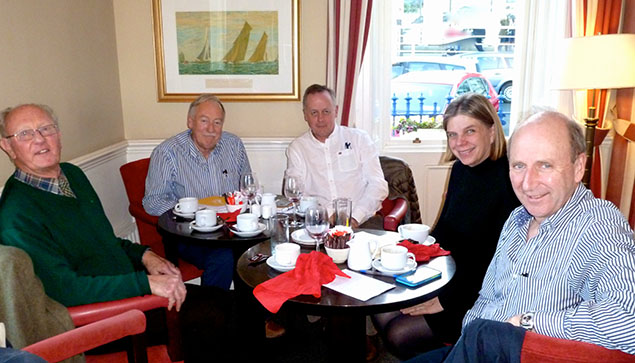
Even before Sean and his team had left for London for the OGA changeover, the word had come through from Paul Keogh, skipper of the Clondalkin community-owned-and-built full-size Galway Hooker Naomh Cronan, that he and his crew would be delighted to take part in Dun Laoghaire in July.
This was another key decision, for the Naomh Cronan is now the only full-sized traditional Galway type on the Irish Sea. But while the great hooker voyager Paddy Barry now sails the seas in a 45ft Frers-designed cutter, it was also confirmed that he too would be taking part, as crew aboard Sean Walsh’s Tir n nOg.
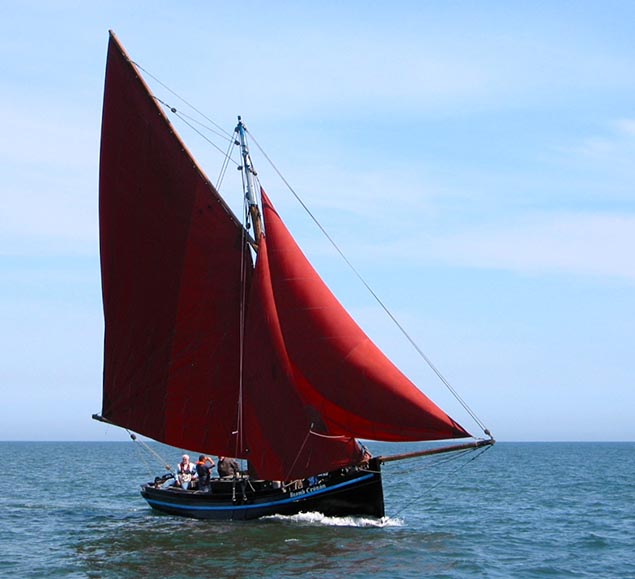 The Clondalkin community-built Galway Hooker Naomh Cronan. Her commitment to the Dun Laoghaire Traditional regatta has greatly encouraged the organisers. Photo: W M Nixon
The Clondalkin community-built Galway Hooker Naomh Cronan. Her commitment to the Dun Laoghaire Traditional regatta has greatly encouraged the organisers. Photo: W M Nixon
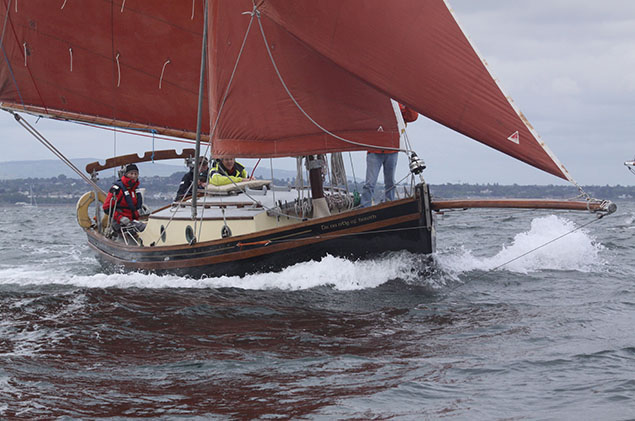 Sean Walsh’s Heard 28 Tir n nOg in racing mode. In Dun Laoghaire in July 2017, his crew will include legendary Galway hooker voyager Paddy Barry. Photo: Dave Owens
Sean Walsh’s Heard 28 Tir n nOg in racing mode. In Dun Laoghaire in July 2017, his crew will include legendary Galway hooker voyager Paddy Barry. Photo: Dave Owens
So the main building blocks of a great event are now going into place, and it’s a matter of building on this sound foundation. With the organisers fully aware of the need to provide proper liaison officers for each special group or class, the need for designated berthing between the Carlisle Pier and the East Pier is also being addressed, as it is the most suitable space, and has the bonus of providing the best possible public view of some of the most interesting-looking boats around.
Thus invitations are on their way to the likes of Scott and Ruth Metcalfe with their characterful schooner Vilma on the Menai Straits, and Mike Clark with his traditional Manx nobby White Heather at Peel in the Isle of Man.
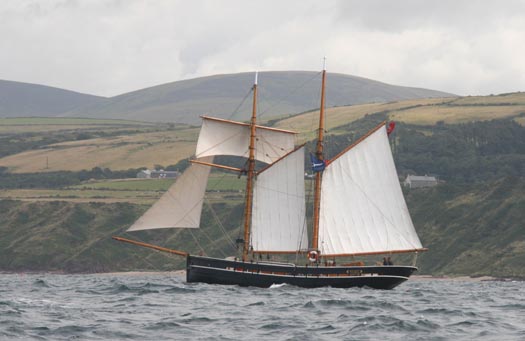 The Menai Straits-based schooner Vilma (Scott & Ruth Metcalf) is exactly the kind of vessel the Dun Laoghaire event is aimed at. Photo: W M Nixon
The Menai Straits-based schooner Vilma (Scott & Ruth Metcalf) is exactly the kind of vessel the Dun Laoghaire event is aimed at. Photo: W M Nixon
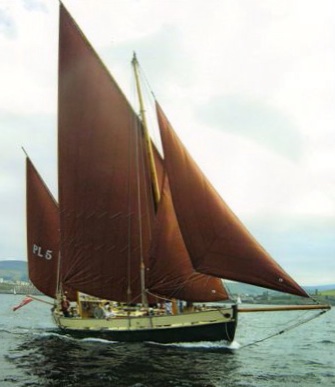 Mike Clark’s Manx Nobby White Heather
Mike Clark’s Manx Nobby White Heather
At the other end of the Isle of Man is Joe Pennington with his restored Manx longliner Master Frank, an asset to any regatta, while across in Strangford Lough Dickie Gomes may have his 1912-built 36ft Kearney yawl Ainmara on the market after 51 years of ownership, but if she doesn’t move he says he is on for Dun Laoghaire.
For several years. Ainmara was Dun Laoghaire-based, but the Dun Laoghaire class which everyone would most particularly welcome back would be the Dublin Bay 24s which raced in the bay from 1947 to 2004. Here’s a rough-cut vid from their final race in the bay in 2004, since then they’ve been taken to Brittany in hope of restoration, but only one has had the complete job done. Originally called Periwinkle, she is now re-named Grace, and is based at Douarnenez, but if she could be persuaded back to Dublin Bay for July 2017, who knows what doors might be opened.
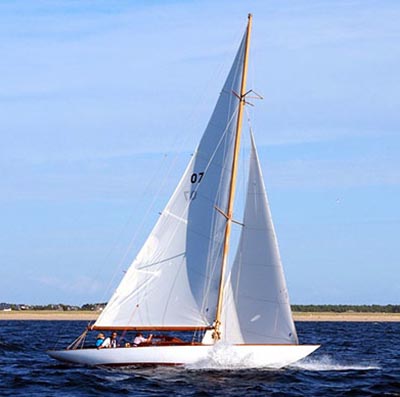 The restored Dublin Bay 24 Grace (ex-Periwinkle) is now reported to be based in Douarnenenz, but she would be very welcome back in Dublin Bay
The restored Dublin Bay 24 Grace (ex-Periwinkle) is now reported to be based in Douarnenenz, but she would be very welcome back in Dublin Bay
Boats of a very different kind came centre stage many years ago in another Hal Sisk initiative, the Bantry Boats built to the design of the ship’s longboat left behind in Bantry after the unsuccessful French invasion of 1796. From the new involvement came the Atlantic Challenge, and you’ll find Bantry Boats at many ports, though there are few enough of them in Ireland. But the Dun Laoghaire festivities would provide an ideal opportunity for them, as the final day of the regatta, Sunday 9th July, is also being pencilled in for a full-on traditional rowing competition for the East Coast Skiffs.
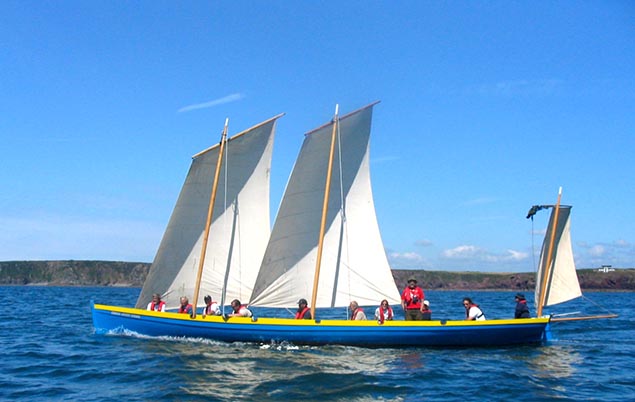 The Pembrokeshire Bantry Boat sailing off the coast of southwest Wales. Some racing for these very special craft is another proposal for the Dun Laoghaire regatta
The Pembrokeshire Bantry Boat sailing off the coast of southwest Wales. Some racing for these very special craft is another proposal for the Dun Laoghaire regatta
In fact, with so much effort being made to provide proper waterfront facilities in Dun Laoghaire, it’s a case of the more the merrier, and another interesting vessel whose management have indicated positive interest is the Conor O’Brien ketch Ilen, currently nearing completion of her restoration through the Ilen Boat Building School of Limerick at Liam Hegarty’s boatyard at Oldcourt near Baltimore.
Ilen is due to be launched in April and will be in full commission by July. The very fact of having a complete suit of new sails will make her look better than she ever has since she was built in 1927, and if she does turn up to Dun Laoghaire welcome, it will be a very different boat from the tired-looking vessel at the end of her working days in the Falkands, the vessel which was finally, thanks to Gary MacMahon’s initiative, returned to Ireland in 1998.
In other words, so many ideas are flying around about the fresh shapes and new vitality that the Kingstown Bicentenary can add to the Volvo Dun Laoghaire Regatta that all things are possible.
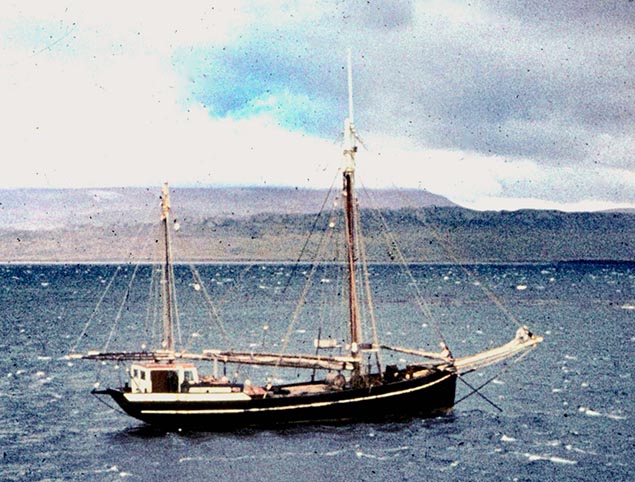 The Conor O’Brien ketch Ilen towards the end of her working days in the Falkland Islands. In fully restored form, she is expected to launch in April of this year, and may well include the Volvo Dun Laoghaire Regatta in her 2017 programme. Photo courtesy Ilen Boatbuilding School
The Conor O’Brien ketch Ilen towards the end of her working days in the Falkland Islands. In fully restored form, she is expected to launch in April of this year, and may well include the Volvo Dun Laoghaire Regatta in her 2017 programme. Photo courtesy Ilen Boatbuilding School
Although this year's 38th Galway Hooker racing at Cruinniú na mBád was cut short due to the high winds there was still plenty of activity at Galway's maritime sailing festival.
'Aisling Geal', Bob Quinn's original 1979 film of the first Cruinniu festival, got an airing on Sunday in the Courthouse and festival goers got a glimpse of how it all began.
This historic boat, Galway Hooker Festival, which has been held in Kinvara each year since '79, celebrates the village's heritage of using turf boats to transport turf from Connemara to south Galway and north Clare.
Crinniu na mBad Currach Race results
Men's and Women's Race
1st Niamh Folan & Jason Folan
2nd Bernie Joyce & Joe Joyce
3rd Nora McDonagh & Michael Folan
4th Georgina Folan & Michael Mulkerins
Junior Race
1st Charlotte Hannon, Bronagh Brennon & Mary McCarthy
2nd Tim Hannon, Georgina Folan & Hayley Folan
Three Men's Final
1st Joe Joyce, Martin Mulkerins & Micheal Mulkerins
2nd John Joe Donoghue, Seanin Honan & Padraig Canavan
Three Ladies Final
1st Leah O'Sullivan, Trish Ward & Annie Lee
2nd Máire Bríd Breathnach, Nora McDonagh & Georgina Folan
3rd Charlotte Hannon, Bronagh Breannan & Mary McCarthy
Galway Hooker For Sale – The Big Lady Lives Again
The traditional Galway Hooker is usually a much-restored craft writes W M Nixon. The climate of Ireland’s Atlantic seaboard is cruel for wooden boats built using basic materials, and the shipwrights of Connemara are skilled in replacing bits and pieces where necessary, or indeed entire boats, while maintaining the spirit and character of the original vessel.
The 38ft An Lady Mor may date back as far as 1872, and if so, then she is the oldest boat to come on the books of the Classic & Traditional Boats section of MGM Boats, where Ross O’Leary remembers the excitement when they achieved the previous record, selling a boat which dated from 1898.
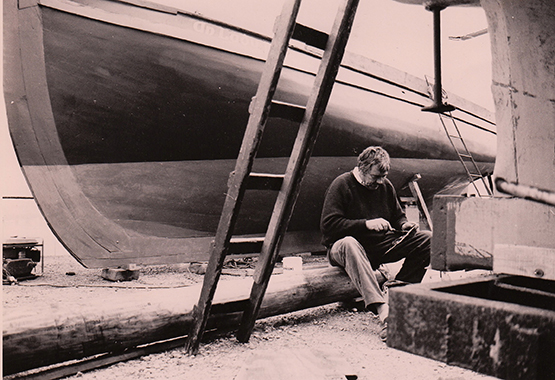 Mick Hunt working on An Lady Mor in 1985
Mick Hunt working on An Lady Mor in 1985
It is well remembered simply because most of their large turnover is in the most modern of glassfibre boats, where anything over twenty years might be considered vintage. But when a community group in Derry who had restored An Lady Mor as a vocational training experience in boat-building decided the sale was necessary, MGM Boats came up on their radar as leaders in boat sales, and now they have an 1872 boat of impeccable traditional pedigree on offer at €50,000.
It all rang a bell with me, as I knew An Lady Mor well in Howth, where she received a previous restoration in 1985 in the capable hands of Mick Hunt, whose brother-in-law Johnny Healion pioneered the Galway Hooker revival in the mid-1970s. An Lady Mor was a fine sight as she was craned afloat in the Spring of 1985, but in those days she was still in the classic open plan which facilitated carrying the maximum amount of turf in the traditional runs from Connemara out to the Aran Islands or across Galway Bay to North Clare.
Then in June of this year while briefly in Greencastle in Donegal, there on the quayside all bright and shiny and restored was An Lady Mor, though now fitted with a coachroof which gives her the bonus of proper sleeping accommodation. In her day, An Lady Mor was one of the more iconic of the Galway hooker fleet, and it’s good to know she has been revived again.
Then in June of this year while briefly in Greencastle in Donegal, there on the quayside all bright and shiny and restored was An Lady Mor, though now fitted with a coachroof which gives her the bonus of proper sleeping accommodation. The coachroof was fitted in 1998 by Ben McDonagh in Malahide - he’d bought the boat from Mick Hunt in 1992 – and with other mods for cruising including an 80hp Lamborghini diesel auxiliary, Ben cruised her extensively with voyages to the Continent. In 2005 he sold her to the group in Derry, who commissioned the noted boatbuilders McDonald’s of Greencastle to undertake her recent refit. In her day, An Lady Mor was one of the more iconic of the Galway hooker fleet, and it’s good to know she has been revived again.
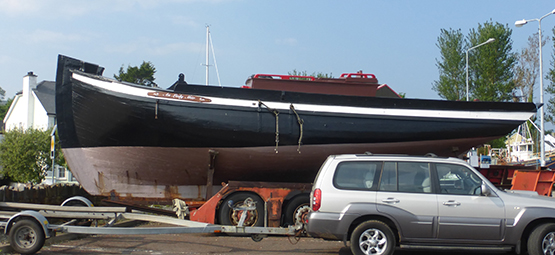
See the full listing for An Lady Mor on Afloat Boats for Sale
Galway Hooker Documentary On RTE One, Monday May 23rd
“Badoiri”, Joe St Leger’s documentary about the people and the western world of the traditional Galway Hookers, is due for its first screening on Monday May 23rd on RTE One at 7.30pm writes W M Nixon
As Afloat.ie previously reported, The storyline covers the varying fortunes of the traditional craft of Connemara and those who have built them, re-built them and sailed them during the past thirty years. This period has seen a revival of enthusiasm for the traditional sailing boats, which used to be the backbone of the transport system in the Galway Bay region and beyond.
Now used mainly for regatta racing and also for the traditional ceremonial transportation of Connemara turf to Kinvara in the southeast corner of Galway Bay in the annual festival of Crinniu na mBad (the Gathering of the Boats) each August, the documentary’s use of both old film and rare still photographs evokes the spirit of a place, a people and their traditional boats which for many of us express the very essence of Ireland.
Bádóirí-Photographing the Last of the Galway Hooker Men – RTE One Documentary Airs This Month
'Bádóirí–photographing the last of the Galway Hooker Men’ a documentary by sailor and photographer Joe St. Leger will air on RTE One television on Monday 23rd May 2016 at 7.30pm.
The film relates the story of these unique Irish workboats and the men who sailed them using black and white photographs taken over 35 years ago when St. Leger was starting out as a photographer with the Irish Press in Dublin
Using still images and film footage taken over thirty years ago photographer St Leger tells the story of photographing the last of the hooker boatmen of Connemara.
For centuries Galway hookers sailed the waters of Galway Bay transporting people, goods and animals and connecting remote coastal communities with the Aran Islands, Galway city and market towns like Kinvara.
Transport and fishing once provided work for hundreds of these boats and their crews but by the 1960s their working days were coming to an end and many old boats were abandoned.
In the 1980’s attempts were made to revive interest in the craft starting with the annual Crinniú na mBád or Gathering of the Boats in Kinvara and to preserve for for future generations the skills needed to build and to sail them.
This film uses photographs taken during the revival to document what remained of the Galway hookers and of the people and places associated with them.
Portaferry Sails & Sounds Will Broaden Life In The Narrows
The revival of Portaferry in Strangford Narrows as a mid-summer focal point for classic and traditional sail afloat, combined with traditional music and festivities ashore, is set to take place from Thursday June 16th to Sunday June 19th this year with the newly branded and re-vamped Portaferry Sails & Sounds Festival 2016 writes W M Nixon
Time was when the highlight for traditional sailors at Portaferry, where the tides sluice with some strength in and out of Northern Ireland’s saltwater lake of Strangford Lough, was racing by restored Galway hookers - they came north in substantial numbers in late June from their home ports in the greater Dublin area. But it is the new Dublin-Galway motorway – of all things - which has seen numbers of traditional craft around Dublin Bay decline as they migrated back to their newly-accessible true heartlands around Galway Bay, such that now if you want to be sure to see hookers - including many Dublin-owned ones - racing in strength, you need to go Macdara’s Island off Connemara for St MacDara’s Day – July 16th – or to Kinvara at the head of Galway Bay for Cruinniu na mBad, which in 2016 is August 19th to 21st.
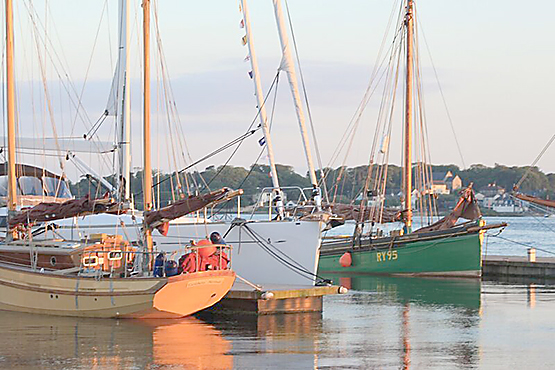
Alan and Irene Aston’s Cornish Crabber Golden Nomad in Portaferry Marina, while beyond with bowsprit housed is Joe Pennington’s famous Manx Longliner Master Frank
But there are other places in the Irish Sea where traditional craft and interesting old gaffers are to be found, notably in North Wales and particularly in the Isle of Man, where Joe Pennington has restored the last Ramsey Longliner – Master Frank – into superb sailing conditions, while Mike Clark continues to maintain the Manx nobby White Heather under her classic labour-intensive lugger rig.
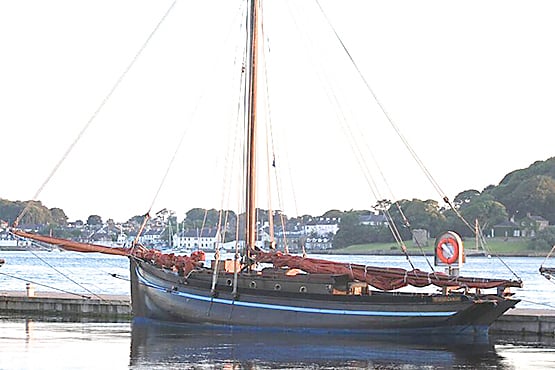
Naomh Cronan in Portaferry Marina
As well of course, the big Clondalkin-originated Galway Hooker Naomh Cronan continues to make the Irish Sea her home base, sailing from Poolbeg in Dublin, and there’s an increasing number of classic restored gaff yachts at many centres all round the Irish Sea and the Firth of Clyde, which link together through the Old Gaffers Association. This will provide a real increase in the fleet which this year will make Portaferry a major happening again, the interest further heightened by the presence of Strangford Lough’s fleet of nine-plus Iain Oughtred-designed four-oared skiffs, which have a regular racing programme in the lough.
The Strangford Village Rowing Club’s skiff in action at their home port, with Portaferry just across the narrows. Photo: W M Nixon
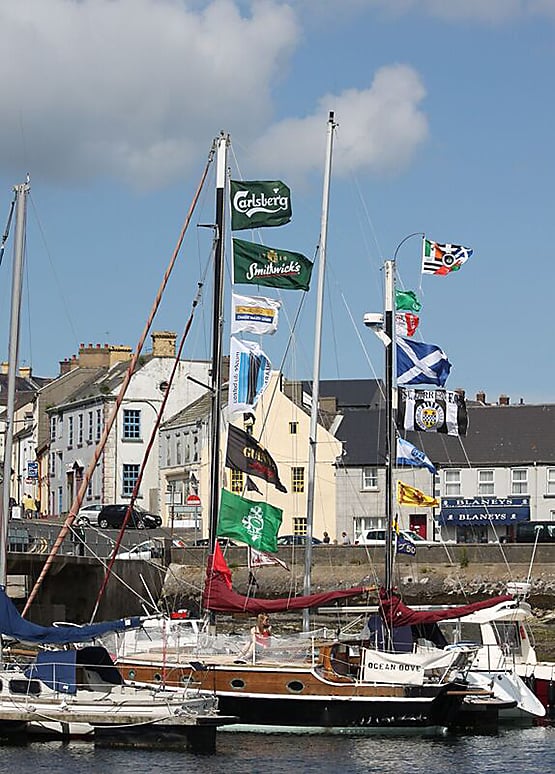
Gary Lyons’ ketch Ocean Dove in party mode in Portaferry Marina
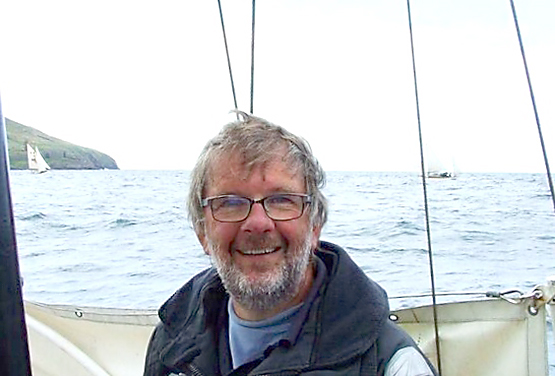
Adrian “Stu” Spence, one of the main movers and shakers behind the new-look Portaferry Sail & Sounds 2016 in June.
The two powers in the land who are making sure it all takes off are Garry Lyons of the Northern Ireland Old Gaffers Association, skipper of the vintage ketch Ocean Dove, and another northern sailor, the legendary Adrian “Stu” Spence, who in 2014 finally parted from his incredibly old Pilot Cutter Madcap (she may have dated back as far as 1873), which over many seasons he’d cruised to places as distant and different as Greenland and Spain.
In the Autumn of last year he came into Poolbeg with his new Mediterranean-acquired vessel, a rakishly clipper-bowed Vagabond 47 ketch which Skipper Spence currently refers to as “The Love Boat” – we look forward to learning of the official name in due course. The new ship was in Poolbeg in order to access the specialist talents whom Stu Spence has got to know during his long years with the Old Gaffers, in order to make the big ketch fit for anything before she finally goes on to her home mooring at Ringhaddy in Strangford Lough, and she’ll admirably fulfill the role of one of the flagships for Portaferry Sails and Sounds in June.
Stu Spence currently refers to his newly-acquired Vagabond 47 ketch – seen here in Poolbeg Marina – as “The Love Boat”. Photo: W M Nixon
Run jointly by the Northern Ireland Old Gaffers Association and Portaferry Sailing Club, Portaferry Sails & Sounds 2016 promises the perfect mixture of sport and spectacle, sailing and singing, and dancing and divilment to make the Midsummer Weekend pass merrily in the classic and traditional style.
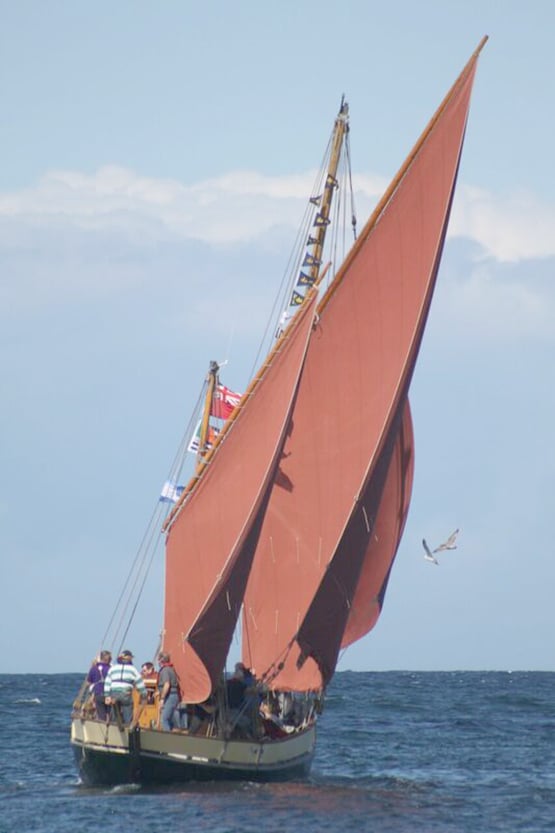
Mike Clark’s traditionally-rigged Manxy Nobby White Heather from Peel is expected in Portaferry in June
Rás Na Húicéirí Go Ciarraí On TG4 Tonight
#GalwayHooker - Tune in to TG4 tonight (Saturday 2 January) at 8.30pm for a special look back at the first Galway Hooker race from Aran to Kerry almost three decades ago.
Rás na Húicéirí go Ciarraí 1987 features highlights of the event – and catches up years later when four boats lined up to retrace that historic race.
Galway Boat To Be Renamed In Honour Of Murdered Student
#ClassicBoats - A classic Galway hooker being restored by Claddagh boatmen is to be renamed in commemoration of murdered student Manuela Reido.
As Galway Bay FM reports, the boat currently known as Fiona will be renamed Manuela after a unanimous vote by Galway City councillors, in honour of the 17-year-old English language student who was killed just days after arriving in the city in October 2007.
The boat is currently being restored as part of the new Claddagh boatbuilding project, reviving a tradition of boatcraft in the district not seen since the 1930s, as previously reported on Afloat.ie.



























